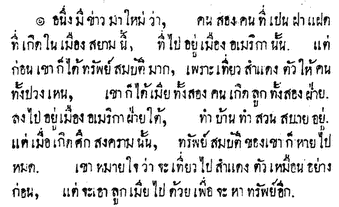[Note: See also in this series introduction, sorting, orthography, pronunciation guides, and word senses. Forthcoming: etymology and list of abbreviations.]
Lest you, dear reader, should run out reading material, let's plow ahead with part four of the Know Your Dictionary series (the original Thai can be found here):
Part 3: Symbols
Insofar as these rules are consistently followed in the dictionary, these symbols are very important to understand for making fine distinctions within the dictionary entry. There are still some unfortunate ambiguities, like points A and B under the semi-colon section (it would be nice if they distinguished these).
Also, the use of the hyphen in headwords is extremely important and one of the things RID does very well, compared with many or most other dictionaries.
If a complex dictionary like this one, complete with this explanation, isn't an argument for the introduction of more Western-style punctuation into Thai, I don't know what is. Thai would lose some of its mystique, perhaps, and no doubt some would claim its "Thainess", but communication would certainly be improved. Reading flowing Thai text without tripping up is hard! So, good thing the Royal Institute took the time to think through and decide to use punctuation.
Lest you, dear reader, should run out reading material, let's plow ahead with part four of the Know Your Dictionary series (the original Thai can be found here):
Part 3: Symbols
1. Comma ( , )And the commentary:A. Used between similar senses of a word within a definition, e.g. กระตือรือร้น ก. รีบร้อน, เร่งรีบ, ขมีขมัน, มีใจฝักใฝ่เร่งร้อน.
a. Separates the definition from synonyms, e.g. เข้าโกศ ก. บรรจุศพลงในโกศ, ลงโกศ ก็ว่า.
b. When a synonym comes after a sense followed by a semicolon (;), it means that synonym applies only to the sense after the semicolon, e.g. ไข่ข้าว น. ไข่ที่ฟักไม่เป็นตัว ต้มแล้วแข็งและเหนียวผิดปรกติ; ไข่ปอกเสียบ ไม้ปักไว้บนยอดบายศรี, ไข่ขวัญ ก็เรียก. (ดู ขวัญ).B. Used after the last sense before an illustrative example to show that the example applies to all preceding senses, e.g. ขวย ก. กระดาก, อาย, เช่น แก้ขวย ขวยใจ. If there is no comma, it shows that the example applies only the immediately preceding sense, e.g. ขีดคั่น ก. ขีดกั้นไว้, กำหนดไว้โดยเฉพาะ เช่น อ่านหนังสือไปถึงไหนแล้ว ให้ทำเครื่องหมายขีดคั่นไว้. C. Used after the last definition before more details about the headword, e.g. ถลอก [ถะหฺลอก] ก. ลอกออกไป, ปอกออกไป, เปิดออกไป, (มักใช้แก่สิ่งที่มีผิว) เช่น หนังถลอก สีถลอก. D. Used between etymological abbreviations, particularly those from Pali and Sanskrit whose orthography is the same as the headword, e.g. ทวิ has parentheses giving the etymology as (ป., ส.).
2. Semi-colon ( ; )A. Used between each definition that has many senses, and those senses are different but are still related to the original sense, e.g กิ่ง น. ส่วนที่แยกออกจากต้น, แขนง; ใช้เรียกส่วนย่อยที่แยกออกไปจากส่วนใหญ่ แต่ยังขึ้นอยู่กับส่วนใหญ่ เช่น กิ่งอำเภอ กิ่งสถานีตำรวจ; ลักษณนามเรียกงาช้างว่ากิ่ง; ชื่อเรือชนิดหนึ่งในกระบวนพยุหยาตรา. B. Used between definitions of a word with unrelated meanings, e.g. เจริญ [จะเริน] ก. เติบโต, งอกงาม, ทำให้งอกงาม, เช่น เจริญทางพระราชไมตรี เจริญสัมพันธไมตรี, มากขึ้น; ทิ้ง เช่น เจริญยา, จำเริญยา ก็ว่า; ตัด เช่น เจริญเกศา, จำเริญเกศา ก็ว่า; สาธยาย, สวด, (ในงานมงคล) เช่น เจริญพระพุทธมนต์. C. Used at the end of a definition, before the synonyms, for headwords with various definitions, to show that those synonyms apply to all senses of the headword, e.g. ปทัสถาน น. แบบแผนสำหรับยึดถือเป็นแนวทางปฏิบัติ; เหตุที่ตั้งเป็นเครื่องถึง, เหตุอันใกล้ที่สุด; บรรทัดฐาน หรือ ปทัฏฐาน ก็ว่า. (ส.; ป. ปทฏฺ?าน). D. Used between etymological abbreviations, particularly those form Pali and Sanskrit whose orthography is different from the headword, e.g. ศีรษะ has parentheses giving the etymology as (ส.; ป. สีส), and เขม-, เขมา has the etymology (ป.; ส. เกฺษม).
3. Hyphen ( - )A. Used in place of the omitted first part of a double, e.g. –กระส่าย ใช้เข้าคู่กับคำ กระสับ เป็น กระสับกระส่าย. –กระเฟียด ใช้เข้าคู่กับคำ กระฟัด เป็น กระฟัดกระเฟียด. B. Used after Pali or Sanskrit words to show that other words can be affixed to them, e.g. อัคร- สม- ศาสตร- C. Used in place of unambiguous syllables of a pronunciation guide, e.g. ชบา [ชะ-] or ยี่หร่า [–หฺร่า] D. Used between each syllable of a pronunciation guide for words with ambiguous pronunciation, e.g. เพลา [เพ-ลา] or เสมา [เส-มา]
4. Period ( . )A. Used at the end of a definition, e.g. กำแหง [–แหง] ว. แข็งแรง, กล้าแข็ง, เข้มแข็ง. ก. อวดดี. B. Used after parentheses which give the etymology of a word or source of a citation, e.g. กำจาย ๑ ก. กระจาย. (ข. ขฺจาย). กระโสง (กลอน) น. ปลากระสง เช่น กระโสงสังควาดหว้าย ชลา. (สรรพสิทธิ์).
Insofar as these rules are consistently followed in the dictionary, these symbols are very important to understand for making fine distinctions within the dictionary entry. There are still some unfortunate ambiguities, like points A and B under the semi-colon section (it would be nice if they distinguished these).
Also, the use of the hyphen in headwords is extremely important and one of the things RID does very well, compared with many or most other dictionaries.
If a complex dictionary like this one, complete with this explanation, isn't an argument for the introduction of more Western-style punctuation into Thai, I don't know what is. Thai would lose some of its mystique, perhaps, and no doubt some would claim its "Thainess", but communication would certainly be improved. Reading flowing Thai text without tripping up is hard! So, good thing the Royal Institute took the time to think through and decide to use punctuation.


